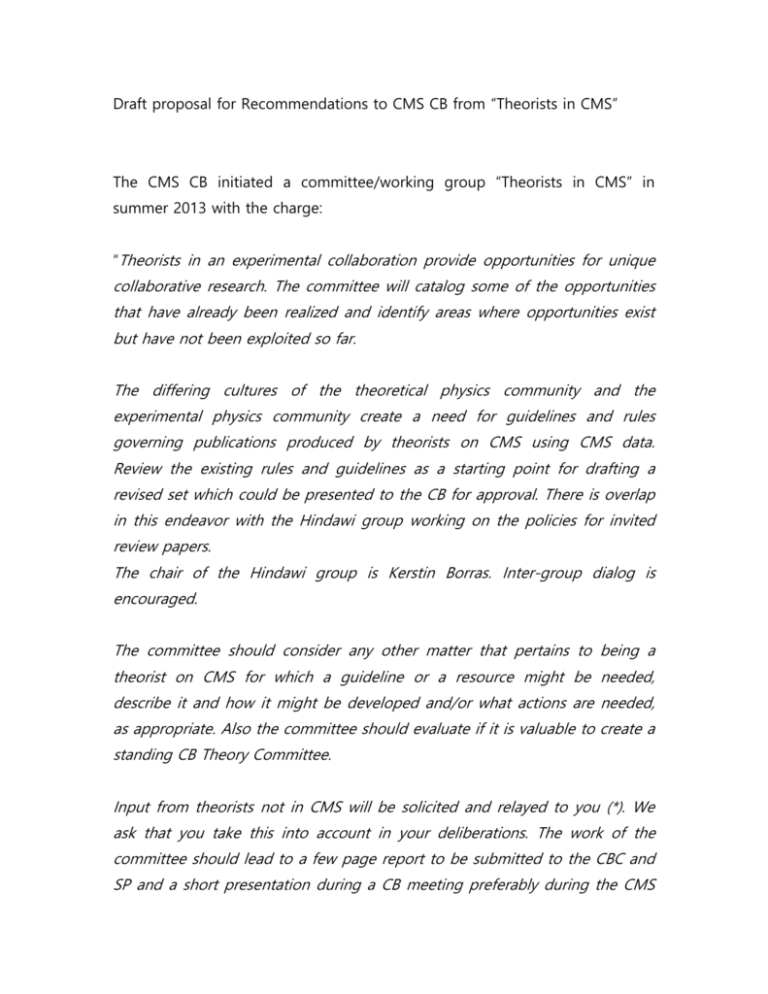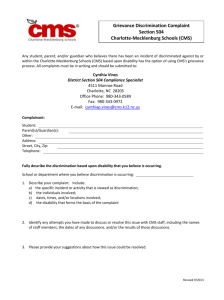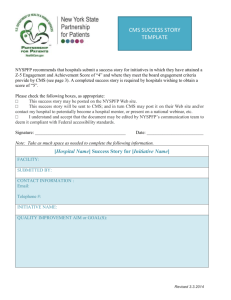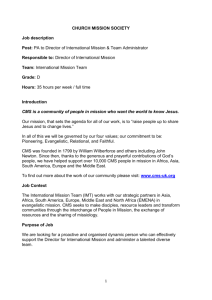Draft proposal for Recommendations to CMS CB from “Theorists in
advertisement

Draft proposal for Recommendations to CMS CB from “Theorists in CMS” The CMS CB initiated a committee/working group “Theorists in CMS” in summer 2013 with the charge: “Theorists in an experimental collaboration provide opportunities for unique collaborative research. The committee will catalog some of the opportunities that have already been realized and identify areas where opportunities exist but have not been exploited so far. The differing cultures of the theoretical physics community and the experimental physics community create a need for guidelines and rules governing publications produced by theorists on CMS using CMS data. Review the existing rules and guidelines as a starting point for drafting a revised set which could be presented to the CB for approval. There is overlap in this endeavor with the Hindawi group working on the policies for invited review papers. The chair of the Hindawi group is Kerstin Borras. Inter-group dialog is encouraged. The committee should consider any other matter that pertains to being a theorist on CMS for which a guideline or a resource might be needed, describe it and how it might be developed and/or what actions are needed, as appropriate. Also the committee should evaluate if it is valuable to create a standing CB Theory Committee. Input from theorists not in CMS will be solicited and relayed to you (*). We ask that you take this into account in your deliberations. The work of the committee should lead to a few page report to be submitted to the CBC and SP and a short presentation during a CB meeting preferably during the CMS week in December 2013.” A survey to investigate the role, the difficulties, the frustrations and wishes for a collaboration with physicists with background in theoretical particle physics and phenomenology (for short called theorists below) has been issued in Oct 2013, evaluated and has led to a presentation at the Dec 2013 CB meeting. In total 58 theorists and 196 CMS members responded (Responses of survey). In 2013 CMS had 8 full signing theorists and 6 affiliates. The results of the survey and direct discussions with theorists being full signing CMS members as well as affiliates lead to the following observations and recommendations to the CB: The current system allows for theorists to be: full members of the collaboration where they are members of an institute which is a member of CMS a member of an institute’s group, but not an M&O A paying author and therefore not a signatory of all CMS publications (CMS affiliate, according to Annex 1.5 of CMS constitution) associated with a particular piece of work on an ad hoc basis. In this case the individual is not necessarily a member of an institute, which is a member of CMS. This association is agreed on an informal level on the basis of “good scientific practice”, while allowing the theorist to see also internal results and to interact with the analysis team. A full member of CMS has to propose such an informal association to the PAG conveners and Physics Coordination for approval. Individuals usually find that one of these modes of operation suits them well. Some find that a formal association with CMS leads to significant levels of bureaucracy and they find this a deterrent to becoming a full member. It was expressed that an informal collaboration with theorists outside CMS should be encouraged. We find all of these modes of interaction valuable and recommend that they all remain possible options. The scientific exchange with theorists within and outside CMS is beneficial for the quality of CMS results and publications and is regarded as an enrichment of the scientific discussion and scientific culture in CMS. In general both experimentalists and theorists expressed a desire to interact in a variety of ways such as targeted workshops, individual presentations and collaborative working, as well as for short-term fellowships to participate on dedicated topics. In many cases, theorists in CMS act as consultants on theory questions as well as contact persons to outside theorists. In order to increase the visibility and the influence, a more formal role like an official contact person of those activities would be appreciated. It has been noted that in the spectrum of activities of individuals there is often not a clear distinction between “theorists” and “experimentalists” and that all members of CMS should first and foremost be regarded as physicists. In the following we assume that the recommendations for “good scientific practice” and especially ”frankness and fairness with regard to the contributions of partners, competitors, and predecessors” 1 are followed, and 1 European Science Foundation Policy Briefing “Good scientific practice in research and that specific rules only apply to very specific cases, which we detail in the appendix. Recommendations, following from discussion and the evaluation of the survey: We recommend encouraging intense, continuous exchange with theorists within CMS as well as with outside theorists. Such communication and exchange leads to a better understanding of the experimental measurements by the theory and phenomenology community (beyond what is and can be written in publications) as well as it ensures the use of the state-of-art theory, models and calculations in comparison with our experimental results. We encourage collaboration with theorists with low bureaucratic and formal threshold. Such collaboration can be achieved by inviting theorists to become a full member of CMS, a CMS affiliate or by informal contact. The access to internal results and internal meetings follows the “good scientific practice”, and only in special cases special restrictions and agreements are required. We propose the installation of theory/phenomenological contact person per PAG in order to: o provide a point of contact for theorists external to CMS. This may encompass such activities as answering question on publications and directing questions to appropriate people working on specific analyses. o provide experimentalists with information on where to obtain scholarship” http://www.esf.org/fileadmin/Public_documents/Publications/ESPB10.pdf advice on theoretical questions. This may be from within the collaboration or from experts external to the collaboration. In addition the contact persons should encourage theorists with relevant expertise to give presentations to the appropriate PAGs. The contact persons from the different PAGs should interact amongst themselves to ensure consistency throughout the collaboration. We propose and encourage common sessions and workshops (can be PAG meetings, preferably organized cross PAGs) to initiate, stimulate and intensify discussion with theorists and phenomenologists at a informal level while respecting “good scientific practice”. We propose to continue and maintain short-term (1 month -> 2 years) affiliations and to collaborate with the Physics Centers at CERN, DESY and Fermilab for short-term fellowships with financial support (at least to cover travel expenses). Appendix CMS publications are everything that is public, i.e. PAS preliminary results, public Twiki pages or journal publications. In all cases we should guarantee that CMS members have the same chances as outside theorists, i.e. they should be allowed to use and publish in the same way (under their own name) any result which is made public (even if unpublished in a journal or only available on a public Twiki or public PhD server), if it is of interest for their scientific publication. We recommend that private publications are sent to Physics Coordination and to the chairs of the corresponding PAG prior to sending it to the arXiv or journal. Any member of CMS should seek to include their ideas or observations in a CMS publication whenever appropriate. If either CMS does not wish to include this information or the member is unaware of the CMS result before it is published, then the member of CMS may use the published information in their own non-CMS publication at any time. If a member of CMS explicitly wishes not to include ideas or information in a CMS publication where it would have been appropriate, they must not seek to publish, making use of CMS published results, for a period of at least two weeks subsequent to the CMS publication.





